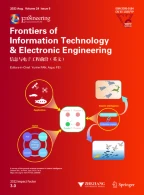Abstract
We propose a novel dynamic traffic signal coordination method that takes account of the special traffic flow characteristics of urban arterial roads. The core of this method includes a control area division module and a signal coordination control module. Firstly, we analyze and model the influences of segment distance, traffic flow density, and signal cycle time on the correlation degree between two neighboring intersections. Then, we propose a fuzzy computing method to estimate the correlation degree based on a hierarchical structure and a method to divide the control area of urban arterial roads into subareas based on correlation degrees. Subarea coordination control arithmetic is used to calculate the public cycle time of the control subarea, up-run offset and down-run offset of the section, and the split of each intersection. An application of the method in Shaoxing City, Zhejiang Province, China shows that the method can reduce the average travel time and the average stop rate effectively.
Similar content being viewed by others
References
Febbraro, A.D., Giglio, D., Sacco, N., 2015. A deterministic and stochastic Petri net model for traffic-responsive signaling control in urban areas. IEEE Trans. Intell. Transp. Syst., 17(2): 510–524. http://dx.doi.org/10.1109/TITS.2015.2478602
Gartner, N.H., Stamatiadis, C., 2004. Progression optimization featuring arterial-and route-based priority signal networks. Intell. Transp. Syst., 8(2): 77–86. http://dx.doi.org/10.1080/15472450490437771
Kong, Q.J., Li, L.F., Yan, B., et al., 2013. Developing parallel control and management for urban traffic systems. IEEE Intell. Syst., 28(3): 66–69. http://dx.doi.org/10.1109/MIS.2013.59
Kong, X.J., Shen, G.J., Xia, F., et al., 2011. Urban arterial traffic two-direction green wave intelligent coordination control technique and its application. Int. J. Contr. Autom. Syst., 9(1): 60–68. http://dx.doi.org/10.1007/s12555-011-0108-4
Kumar, P., Merzouki, R., Conrard, B., et al., 2014. Multilevel modeling of the traffic dynamic. IEEE Trans. Intell. Transp. Syst., 15(3): 1066–1082. http://dx.doi.org/10.1109/TITS.2013.2294358
Lee, J.H., Lee-Kwang, H., 1999. Distributed and cooperative fuzzy controllers for traffic intersections group. IEEE Trans. Syst. Man Cybern. C, 29(2): 263–271. http://dx.doi.org/10.1109/5326.760570
Lertworawanich, P., Kuwahara, M., Miska, M., 2011. A new multiobjective signal optimization for oversaturated networks. IEEE Trans. Intell. Transp. Syst., 12(4): 967–976. http://dx.doi.org/10.1109/TITS.2011.2125957
Liu, Z.Y., 2003. Intelligent Traffic Control Theory and Application. Science Public House, Beijing, China, p.22–23 (in Chinese).
Lu, K., Xu, J.M., Zheng, S.J., 2009. Correlation degree analysis of neighboring intersections and its application. J. South China Univ. Technol. Nat. Sci., 37(11): 37–42 (in Chinese).
Pillai, R.S., Rathi, A.K., Cohen, S.L., 1998. A restricted branch-and-bound approach for generating maximum bandwidth signal timing plans for traffic networks. Transp. Res. B-Method, 32(8): 517–529. http://dx.doi.org/10.1016/S0191-2615(96)00033-1
Ren, S.P., Shen, G.J., 2010. Intelligent hybrid forecasting technique for short-term traffic flow. J. Zhejiang Univ. (Eng. Sci.), 44(8): 1473–1478 (in Chinese).
Shen, G.J., Kong, X.J., 2009. Study on road network traffic coordination control technique with bus priority. IEEE Trans. Syst. Man Cybern. C, 39(3): 343–351. http://dx.doi.org/10.1109/TSMCC.2008.2005842
Shen, G.J., Sun, Y.X., 2002. Multi-phase fuzzy traffic control based on phase sequencer. Contr. Dec., 17(Suppl.): 654–658 (in Chinese).
Tettamanti, T., Luspay, T., Kulcsár, B., et al., 2014. Robust control for urban road traffic networks. IEEE Trans. Intell. Transp. Syst., 15(1): 385–398. http://dx.doi.org/10.1109/TITS.2013.2281666
Wu, W.G., Zhang, J.B., Luo, A.X., et al., 2015. Distributed mutual exclusion algorithms for intersection traffic control. IEEE Trans. Parall. Distr. Syst., 26(1): 65–74. http://dx.doi.org/10.1109/TPDS.2013.2297097
Author information
Authors and Affiliations
Corresponding author
Additional information
Project supported by the National Natural Science Foundation of China (No. 61174174), the Science and Technique Program of Zhejiang Province, China (No. 2015C31059), and the Science and Technique Program of Zhejiang Provincial Department of Transportation, China (No. 2014T08)
ORCID: Guo-jiang SHEN, http://orcid.org/0000-0003-1064-1250
Rights and permissions
About this article
Cite this article
Shen, Gj., Yang, Yy. A dynamic signal coordination control method for urban arterial roads and its application. Frontiers Inf Technol Electronic Eng 17, 907–918 (2016). https://doi.org/10.1631/FITEE.1500227
Received:
Accepted:
Published:
Issue Date:
DOI: https://doi.org/10.1631/FITEE.1500227
Keywords
- Urban arterial
- Control subarea
- Coordination control
- Correlation degree
- Fuzzy logic
- Intelligent transportation
